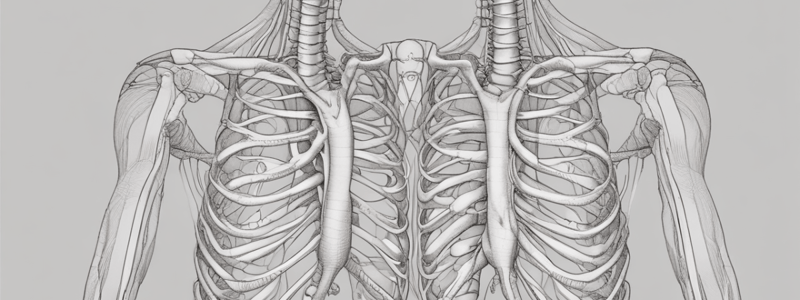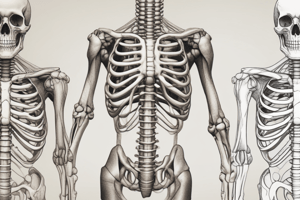Podcast
Questions and Answers
What is the correct definition of costochondral joints?
What is the correct definition of costochondral joints?
- The points where two adjacent ribs meet
- The joints between the ribs and the sternum
- The joints where ribs connect to the vertebrae
- The union between rib and costal cartilage (correct)
Which factor does NOT contribute to the obliquity of the ribcage in adults?
Which factor does NOT contribute to the obliquity of the ribcage in adults?
- Ageing process
- Changes in vertebral column shape
- Effects of gravity
- Genetic predisposition (correct)
How is the space within the thoracic cavity primarily affected?
How is the space within the thoracic cavity primarily affected?
- By the expansion of rib muscles during inhalation
- By lifting the ribcage during thoracic breathing (correct)
- By age-related changes in bone density
- By the positioning of the diaphragm
Which muscles are primarily responsible for preventing excessive displacement of the first rib?
Which muscles are primarily responsible for preventing excessive displacement of the first rib?
What is the relationship between the size of the thoracic cavity and lung capacity?
What is the relationship between the size of the thoracic cavity and lung capacity?
What happens to the capacity of the thoracic cavity as the ribcage is lifted?
What happens to the capacity of the thoracic cavity as the ribcage is lifted?
What role do the scalene muscles play in relation to the 1st rib?
What role do the scalene muscles play in relation to the 1st rib?
What is NOT an aspect of thoracic breathing?
What is NOT an aspect of thoracic breathing?
What anatomical term refers to the upper part of the sternum?
What anatomical term refers to the upper part of the sternum?
Which of the following correctly describes the connection between the parts of the sternum?
Which of the following correctly describes the connection between the parts of the sternum?
What does the term 'angle of Louis' refer to in sternum anatomy?
What does the term 'angle of Louis' refer to in sternum anatomy?
What happens to the sternal angle joint in the elderly?
What happens to the sternal angle joint in the elderly?
The word 'xiphos' in xiphisternum originates from which language and what does it mean?
The word 'xiphos' in xiphisternum originates from which language and what does it mean?
What role does the sternal angle play in the movement of the rib cage?
What role does the sternal angle play in the movement of the rib cage?
Which of the following describes the xiphisternum?
Which of the following describes the xiphisternum?
Which anatomical structure is not part of the rib cage?
Which anatomical structure is not part of the rib cage?
Which spinal nerve is primarily responsible for supplying the skin of the chest above the sternal angle?
Which spinal nerve is primarily responsible for supplying the skin of the chest above the sternal angle?
What is the range of spinal nerves that supply the skin below the plane of the sternal angle anteriorly?
What is the range of spinal nerves that supply the skin below the plane of the sternal angle anteriorly?
Why might multiple intercostal nerves need to be anaesthetised during a procedure involving the nipple?
Why might multiple intercostal nerves need to be anaesthetised during a procedure involving the nipple?
At which dermatome level does the male nipple typically lie?
At which dermatome level does the male nipple typically lie?
What is the primary purpose of an intercostal nerve block?
What is the primary purpose of an intercostal nerve block?
Which of the following describes the overlap of dermatomes over the chest wall?
Which of the following describes the overlap of dermatomes over the chest wall?
Which artery provides blood supply to the internal thoracic region?
Which artery provides blood supply to the internal thoracic region?
What classification best describes the joints of the thoracic cage?
What classification best describes the joints of the thoracic cage?
Which part of a rib is considered atypical?
Which part of a rib is considered atypical?
What is the primary function of the anterior intercostal arteries?
What is the primary function of the anterior intercostal arteries?
Which ribs are categorized as true ribs?
Which ribs are categorized as true ribs?
The drainage system of the internal thoracic veins primarily leads to which vessels?
The drainage system of the internal thoracic veins primarily leads to which vessels?
What role does the pericardiacophrenic artery play in the thoracic cavity?
What role does the pericardiacophrenic artery play in the thoracic cavity?
Which thoracic vertebrae are classified as atypical?
Which thoracic vertebrae are classified as atypical?
What role does the sternocleidomastoid muscle primarily play?
What role does the sternocleidomastoid muscle primarily play?
How does the rib cage of young children differ structurally compared to adults?
How does the rib cage of young children differ structurally compared to adults?
What function does the diaphragm serve in young children?
What function does the diaphragm serve in young children?
What happens if a child is born with a defective diaphragm?
What happens if a child is born with a defective diaphragm?
What is a common characteristic of rib fractures in children compared to adults?
What is a common characteristic of rib fractures in children compared to adults?
What is the relationship between sternocleidomastoid muscle and rib cage movement during breathing?
What is the relationship between sternocleidomastoid muscle and rib cage movement during breathing?
What indicates healed rib fractures in a child's X-ray?
What indicates healed rib fractures in a child's X-ray?
What can result from a diaphragm not forming in its normal position?
What can result from a diaphragm not forming in its normal position?
Flashcards are hidden until you start studying
Study Notes
Anatomy of the Sternum and Rib Cage
- The sternum consists of three parts: manubrium, body, and xiphisternum (xiphoid process).
- The manubrium is referred to as the handle of a dagger, and its name derives from Latin.
- The joint between the manubrium and body is known as the sternal angle (angle of Louis), important for rib cage movements.
- Rib cage structure also includes costal cartilages, ribs, and thoracic vertebrae, forming the thoracic cavity.
- Obliquity of the rib cage reduces space inside, influenced by gravity and aging.
- Thoracic breathing lifts the rib cage, increasing thoracic cavity volume for lung expansion.
Support of the Rib Cage
- Scalene muscles stabilize the first rib by counteracting gravity, attaching cervical vertebrae to the first and second ribs.
- Sternocleidomastoid muscle aids in stabilizing the sternum for breathing, attaching from the sternum and clavicle to the skull.
- In children, the rib cage is more horizontal before walking, relying on the diaphragm for breathing expansion.
Diaphragm and Breathing
- Defective diaphragms in newborns can impair breathing, typically requiring machine assistance on the affected side.
- Adult ribs fracture easily; children's bones are more flexible, potentially accounting for differences in injury presentation.
Educational Outcomes
- Understanding the structure of the chest wall, including the sternum, ribs, intercostal spaces, and vertebrae.
- Familiarity with terminology related to the thoracic cage and distinctions between typical and atypical ribs and vertebrae.
- Knowledge of thoracic cage joints classification and the arrangement of blood vessels, lymphatics, and innervation.
Vasculature of the Chest Wall
- Blood supply to the thoracic wall comes from axillary artery branches, internal thoracic arteries, and thoracic aorta branches.
- Internal thoracic arteries provide anterior intercostal arteries, whereas posterior intercostals arise from the aorta, both anastomosing in the intercostal space.
Internal Thoracic Vessels
- Internal thoracic arteries branch from the subclavian artery; veins drain into brachiocephalic veins.
- They also supply the diaphragm, pericardium, and thymus gland via specific branches.
Innervation and Dermatomes
- Skin above the sternal angle is supplied by the C4 nerve; T2-T6 innervate the area below.
- The nipple usually lies within the T4 dermatome; dermatomes overlap, which may necessitate anesthetizing multiple spinal nerves for surgical interventions.
Conclusion
- Knowledge of the chest wall's form and function is crucial for understanding respiratory mechanics, and it sets the stage for exploring the cardiovascular system in subsequent studies.
Studying That Suits You
Use AI to generate personalized quizzes and flashcards to suit your learning preferences.




